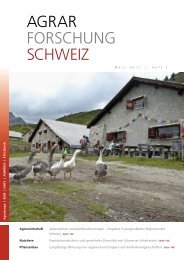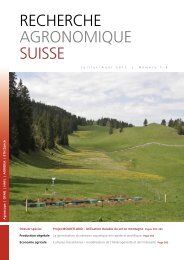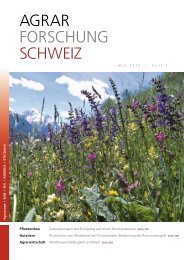Télécharger le PDF - Agrarforschung Schweiz
Télécharger le PDF - Agrarforschung Schweiz
Télécharger le PDF - Agrarforschung Schweiz
You also want an ePaper? Increase the reach of your titles
YUMPU automatically turns print PDFs into web optimized ePapers that Google loves.
Riassunto<br />
Migliorare l’efficacia dell'azoto del liquame<br />
attraverso la sua lavorazione<br />
Le emissioni atmosferiche di azoto degli<br />
ecosistemi agricoli sono aumentate nell'ultimo<br />
decennio, a seguito dell'intensificazione della<br />
produzione agricola. L'agricoltura è la principa<strong>le</strong><br />
fonte di emissioni di composti azotati<br />
quali ammoniaca, nitrati e protossido d'azoto<br />
che possono avere un impatto negativo<br />
sull'ambiente. Nella maggior parte dei paesi<br />
industrializzati l’utilizzo efficace dell’azoto<br />
contenuto nei concimi e la riduzione del<strong>le</strong><br />
emissioni dannose per l'ambiente sono<br />
dunque dei prob<strong>le</strong>mi urgenti da trattare. Le<br />
nuove tecnologie per la lavorazione dei<br />
concimi aziendali, quali ad esempio la fermentazione<br />
anaerobica del liquame, in combinazione<br />
con l'ultrafiltrazione e l'osmosi inversa,<br />
possono rappresentare una soluzione al<strong>le</strong>ttante<br />
per l'agricoltura, in quanto potenzialmente<br />
in grado di ottimizzare l'impiego del<strong>le</strong><br />
sostanze nutritive, ridurre i volumi di liquame<br />
da trasportare e generare energia rinnovabi<strong>le</strong>.<br />
Nel presente studio sono state analizzate <strong>le</strong><br />
proprietà di liquame fermentato e concimi<br />
ottenuti mediante membrane di ultrafiltrazione<br />
e osmosi inversa nonché la rispettiva<br />
efficienza apparente dell'azoto in base al<br />
metodo differenzia<strong>le</strong> in prova in contenitori e<br />
sul campo. Attraverso la lavorazione del<br />
liquame il tenore in azoto ammoniaca<strong>le</strong> dei<br />
concimi ottenuti aumenta, così come la<br />
quantità di azoto nel liquame disponibi<strong>le</strong> per<br />
<strong>le</strong> piante. Siccome vi è pure un aumento del pH<br />
durante la lavorazione il rischio di perdite di<br />
azoto allo stato gassoso durante lo stoccaggio<br />
e lo spandimento segue la medesima tendenza.<br />
Le nuove tecnologie di lavorazione, se<br />
combinate con tecniche di spandimento a<br />
basso carico di emissioni, possono migliorare<br />
la gestione dell'azoto del liquame e ridurne <strong>le</strong><br />
emissioni nell'ambiente.<br />
Traitements pour améliorer l’efficacité de l’azote du lisier | Production végéta<strong>le</strong><br />
Summary<br />
Improving Nitrogen Efficiency via Slurry<br />
Treatment<br />
Over the last few decades, intensified agricultural<br />
production has greatly increased fluxes<br />
of nitrogen (N) between different compartments<br />
of the biosphere, and more specifically,<br />
emissions of N compounds from agroecosystems.<br />
Agriculture is one of the main emitters<br />
of N compounds (e.g. ammonia, nitrate,<br />
nitrous oxide) with negative impacts on the<br />
environment like greenhouse-gas emissions<br />
and contamination of surface and ground<br />
water. Greater efficiency in N-fertiliser use and<br />
the reduction of environmentally harmful N<br />
losses are therefore still urgent matters of<br />
concern for most industrial countries. New<br />
technologies such as anaerobic fermentation<br />
(AF) of slurry combined with subsequent<br />
ultrafiltration (UF) and reverse osmosis (RO)<br />
can be attractive options for agriculture,<br />
potentially enabling to optimise nutrient<br />
management, reduce volumes of transported<br />
slurry, and generate renewab<strong>le</strong> energy. In this<br />
study, anaerobically fermented pig slurry and<br />
fertilizer products from the subsequent<br />
mechanical separation (UF and RO) were<br />
characterised and their apparent N-use<br />
efficiency determined in pot and field experiments<br />
by means of the difference method.<br />
Treatment of pig slurry with AF, UF and RO<br />
increased the ammonium N concentration,<br />
which improved plant N availability. Since the<br />
pH value also increases in paral<strong>le</strong>l during<br />
treatment, the risk of gaseous losses during<br />
storage and application also rises. Neverthe<strong>le</strong>ss,<br />
new slurry-treatment technologies<br />
coup<strong>le</strong>d with low-emission application<br />
techniques (e. g. spreader with trai<strong>le</strong>d hoses)<br />
can potentially both increase the N efficiency<br />
of slurry and reduce N emissions to the<br />
environment.<br />
Key words: anaerobic fermentation, nitrogen<br />
use efficiency, pig slurry, reverse osmosis,<br />
ultrafiltration.<br />
Recherche Agronomique Suisse 1 (10): 378–383, 2010<br />
383
















